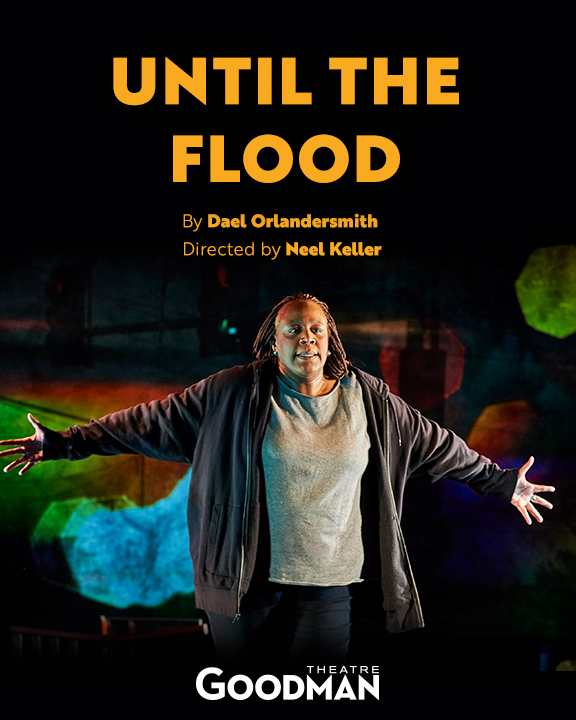
Three-and-a-Half Stars!
 “Until the Flood” is an education as well as entertainment. In this one-person show, writer and performer Dael Orlandersmith takes actual conversations with dozens of black and white respondents from Ferguson, Missouri, and boils these down to play eight different characters of all ages and from all walks of life. The purpose of these interviews, conducted in the spring of 2015, was to garner these individuals’ reactions to the shooting of Michael Brown, an African-American teen, by white police officer Darren Wilson on August 9, 2014. Orlandersmith’s dramatization was originally commissioned and produced by the Repertory Theatre of Seattle and previously performed live on stage. The videotaped version on YouTube is currently being distributed nationwide in conjunction with eight theatres across the country, including Chicago’s Goodman Theatre.
“Until the Flood” is an education as well as entertainment. In this one-person show, writer and performer Dael Orlandersmith takes actual conversations with dozens of black and white respondents from Ferguson, Missouri, and boils these down to play eight different characters of all ages and from all walks of life. The purpose of these interviews, conducted in the spring of 2015, was to garner these individuals’ reactions to the shooting of Michael Brown, an African-American teen, by white police officer Darren Wilson on August 9, 2014. Orlandersmith’s dramatization was originally commissioned and produced by the Repertory Theatre of Seattle and previously performed live on stage. The videotaped version on YouTube is currently being distributed nationwide in conjunction with eight theatres across the country, including Chicago’s Goodman Theatre.
Orlandersmith’s acting is terrific! We watch how facilely each of the eight characters are portrayed from one scene to the next. It is amazing to see how beautifully their patterns of speech are mimicked as they speak in their own voice. All of the monologues are very intense, filled with a wealth of information on how we can comprehend someone else’s reality and their interpretations of it. In fact, there’s so much information to sink in over this one-hour performance that I constantly chose to stop and start the video to capture the rich detail.
These are not direct eyewitness accounts of the shooting of Michael Brown and its violent aftermath but are reactions to events and their repercussions. Two bookends frame the show: namely, Louisa Hemphill’s story. A black woman in her early 70s and a retired schoolteacher, Hemphill describes the Sundown Laws, where those who are Jewish or of color cannot be outside after dark in certain towns. Her account describes the notion of “keeping your place” and “being a Tom” and how “racism causes self-hate.” “Michael Brown,” she says, “was set up and set up to fail.”
Some of the more interesting segments have to do with discussions with friends, family, and strangers as to how each one wrestles with issues of race, ranging from aspirations and career goals to wanting (or not wanting) to live in certain areas of the country. Part of comprehending this reality includes examining politics, socioeconomic status, community norms and values, and family upbringing, and how they may affect perceptions of violence, abuse, and racism—systematic or otherwise.
Hearing Orlandersmith’s own perspective on events and their meaning concludes the performance.
Directed in the theatre by Neel Keller, “Until the Flood” was originally presented before a live audience and videotaped. Projection designer Nicholas Hussong did a fine job recreating the tension that everybody felt on that fateful day, as we see pictures of angry and frightened mobs, newspaper headlines, marches, police officers, etc., interspersed between the various monologues. Unfortunately, filming live theatre does not always work as well as it should. The sound design from the original production doesn’t work well for the video recording: We hear sound that is too hollow, thin, and echoey. Orlandersmith should have been wearing a lavalier, plugged directly into the video recording equipment in addition to speaking into the stage microphones.
By focusing on people grapple with issues of social justice, economic truth, and reality as they see and experience it, this production provides us with a nuanced understanding of race and the racial divide within our nation and within the white and black communities. Orlandersmith does a fantastic job of thrusting first-hand accounts and diverse points of view into the spotlight such that we witness the pain and suffering that goes along with lived experience. To feel empathy, one of the first steps must be the willingness to listen to somebody else’s story in their own words and acknowledge their point of view, and perhaps this show may help to bring the country together and heal old wounds and old cleavages. Said one of the respondents: “Race affects everyone.” As for Michael Floyd, as one of the younger respondents said, “Please God! Don’t let that happen to me.”
The video stream of “Until the Flood” debuted on November 15, 2020, and will continue through the fall of 2023 on YouTube and on the Goodman Theatre website https://www.goodmantheatre.org/UntiltheFlood. This is a free show, although donations to the theatre for this project and others are always welcome.
To see what others are saying, visit www.theatreinchicago.com, go to Review Round-Up and click at “Until The Flood”.







More Stories
“The Magic School Bus: Lost in the Solar System”
“February House” reviewed by Julia W. Rath
” A Lie of The Mind”